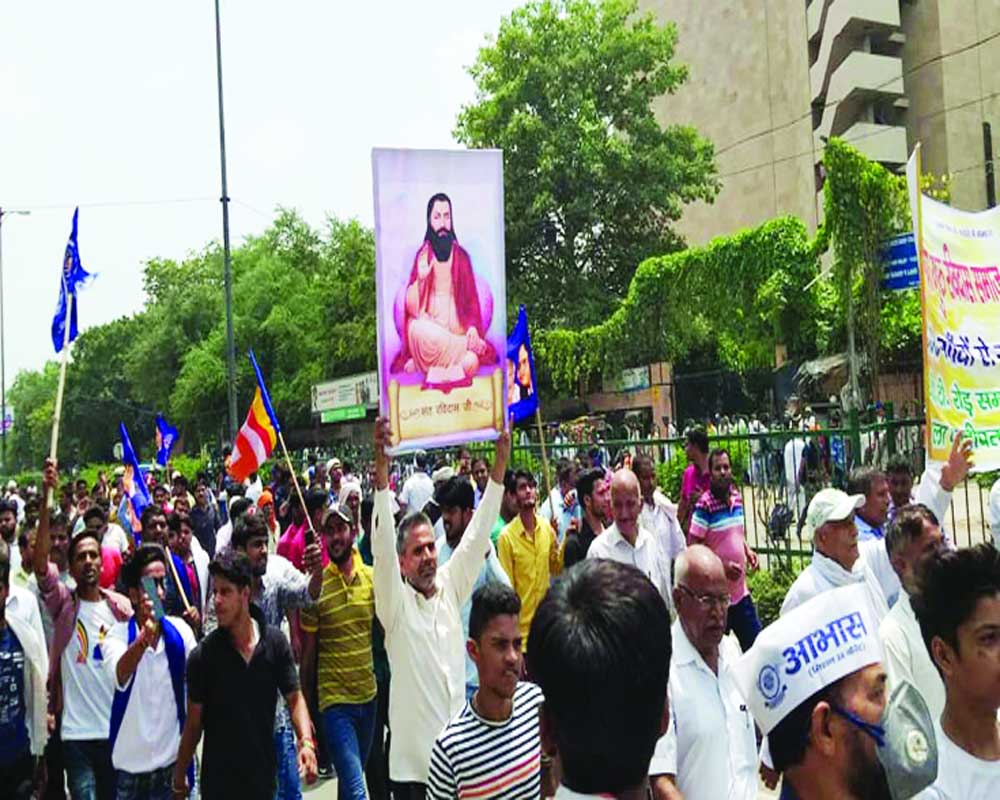Protests over Sant Ravidas’s shrine show that SC/STs are becoming equally aggressive about identity politics
The political import of the thousands of Dalits marching in Delhi to save the shrine of their saint Ravidas is not just about claiming rights and space in a Brahminical order or the appropriation of land as evidenced by the parks of their supreme leader Mayawati. It is about equality and comparative weighing of scales, another form of minority assertion in the face of brute majoritarianism, a question mark on different approaches to the similarity of contexts, and another manifestation of identity politics. Besides, Sant Ravidas embodies a socio-cultural idea of India that undercuts the monolithic imposition of today. Born in the 15th century in Varanasi to leather makers, he denounced the Hindu Brahminical order, challenged deity worship and worked for an egalitarian society against a Hindu Rashtra, becoming the one voice of the marginalised. And such was the power of his messages that many of his disciples even found mention in the Guru Granth Sahib of the Sikhs. None can miss the impactful swathe of this man from Varanasi, unmistakably a prime political constituency today. Nor can the appropriation of the “mandir wahin banayenge” slogan be missed as an equal claimant as the Ram temple in Ayodhya. For starters, both have historicity of belief. Lord Rama was believed to be born in Ayodhya, Guru Ravidas was believed to have visited the Chamarwala Johar in Tughlaqabad 500 years ago. Like Ayodhya, this memorial site is disputed with facts of 1950 differing from facts of 1963, the latter being accepted by the court as encroachment and, therefore, a ground for demolition. Like Ayodhya, status quo has been continuing for years with no party, and even the Delhi Development Authority (DDA), carrying out any demolition on the ground. Like Ayodhya, protesters do not want the memorial shifted as a reconciliatory move and want it on hallowed ground, asking whether Ram temple activists would agree to a commensurate shift in venue? Besides, Dalit activists argue, the construction of Tughlaqabad Ravidas temple is not on the road or creating any obstruction to the general masses. In fact, it can even be part of the Centre’s forest project and, without any other pressing logic, seems just another harassment ploy by the mainstream Right. The latest demolition follows two others by the DDA, one of Buddha Vihar at Devli Hill, and the other at Bhagwan Valmiki Mandir in Seemapuri. Which is why the Tughlaqabad incident has snowballed as a politico-cultural movement, linking both Ravidas and Babasaheb Ambedkar.
The latest round of protests also reflects the growing counter-muscularity in the Dalit leadership, being led from the front by Bhim Army chief Chandrashekhar Azad. His agitationist politics is finding resonance given the waning political influence of Bahujan Samaj Party (BSP) chief Mayawati, who, while arguing for the restoration of the temple, disagreed with the violence associated with it as diluting the key plank. Of course, Behenji still believes Azad to be a foisted creation of the BJP’s ideological parent, the RSS, and there are still a lot of theories as to whether Guru Ravidas followers are being coopted into the Hindutva sub-culture. But considering Azad’s traction among the youth across north India and a combined Dalit iconisation of all leaders, it is a constituency strong enough to negotiate with anybody, not only, as alleged by Mayawati many times, the BJP. Azad may have been deployed as a vote-cutter initially but now has a solid consolidation of Dalit youth, who are countering majoritarian celebrations by scaling up celebrations of Guru Ravidas, Valmiki, Dr Ambedkar, a signal that they do not want to be subsumed or Sankritised in their thinking. Now that the Bhim Army has started working nationwide, Dalit youth are being motivated to assert and not deny their ancestry. This is important given that the young Dalit vote could be a change-maker in the forthcoming Assembly elections. Only this week, Azad launched the Bhim Army Students Federation (BASF) and said he wanted students of Scheduled Castes (SC), Scheduled Tribes (ST), Other Backward Classes (OBC) and religious minorities to be aware of both their rights and duties. Clearly, he is creating a new swell in the existing discourse.


























